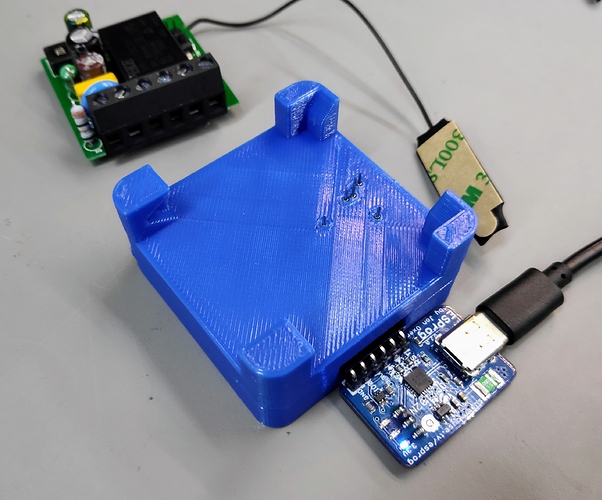Finally, I am not the only one! I’ve been experiencing the same behaviour. But even more issues. Flashed 8 sonoff mini’s with tasmota. Connected wall switches to all of them (between S1 and S2). On one sonoff mini weird stuff is happening.
Two problems I am experiencing:
- Ghostswitching happens at random moments. Light will turn on/off randomly every second and it doesn’t stop untill I flip the physical switch connected between S1/S2. So this is not a “retain setting” issue (the - totally unrelated with this issue - magical solution when looking it up on Google). My wifi signal is 98% and stays connected, so no retain issues.
- Flipping the switch sometimes doesn’t work. I can flip it 6 times and the sonoff mini doesn’t toggle. Feels like an MQTT lag. Sometimes it just works as it is supposed to. Very strange behaviour.
Possible solution for problem number 1? I found online (sonoff basic with tasmota had the same ghost switching issues) that it would be solved by soldering a resistor + capacitor between 3v3 / gpio / ground. Is this a solution for the Sonoff mini too?
What about problem number 2? Any luck yet? Would this “resistor / capacitor” trick also solve that problem?!
See schematic:
27986203-a6668b82-642e-11e7-90bf-a5602a746225__01|685x397
Edit: it just happened again (ghost switching). Here’s the log.
11:31:30 MQT: sonoffschwoonkamer/stat/SWITCH1 = {“STATE”:“TOGGLE”}
11:31:30 MQT: sonoffschwoonkamer/tele/STATE = {“Time”:“2020-01-03T11:31:30”,“Uptime”:“0T11:43:51”,“UptimeSec”:42231,“Heap”:24,“SleepMode”:“Dynamic”,“Sleep”:50,“LoadAvg”:19,“MqttCount”:1,“POWER”:“ON”,“Wifi”:{“AP”:1,“SSId”:“Nanox2.4G”,“BSSId”:“C8:54:4B:95:4B:A1”,“Channel”:6,“RSSI”:100,“Signal”:-47,“LinkCount”:1,“Downtime”:“0T00:00:06”}}
11:31:30 MQT: sonoffschwoonkamer/stat/RESULT = {“POWER”:“ON”}
11:31:30 MQT: sonoffschwoonkamer/stat/POWER = ON
11:31:30 MQT: sonoffschwoonkamer/stat/SWITCH1 = {“STATE”:“TOGGLE”}
11:31:30 MQT: sonoffschwoonkamer/tele/STATE = {“Time”:“2020-01-03T11:31:30”,“Uptime”:“0T11:43:51”,“UptimeSec”:42231,“Heap”:24,“SleepMode”:“Dynamic”,“Sleep”:50,“LoadAvg”:21,“MqttCount”:1,“POWER”:“OFF”,“Wifi”:{“AP”:1,“SSId”:“Nanox2.4G”,“BSSId”:“C8:54:4B:95:4B:A1”,“Channel”:6,“RSSI”:100,“Signal”:-48,“LinkCount”:1,“Downtime”:“0T00:00:06”}}
11:31:30 MQT: sonoffschwoonkamer/stat/RESULT = {“POWER”:“OFF”}
11:31:30 MQT: sonoffschwoonkamer/stat/POWER = OFF
11:31:30 MQT: sonoffschwoonkamer/stat/SWITCH1 = {“STATE”:“TOGGLE”}
11:31:30 MQT: sonoffschwoonkamer/tele/STATE = {“Time”:“2020-01-03T11:31:30”,“Uptime”:“0T11:43:51”,“UptimeSec”:42231,“Heap”:24,“SleepMode”:“Dynamic”,“Sleep”:50,“LoadAvg”:20,“MqttCount”:1,“POWER”:“ON”,“Wifi”:{“AP”:1,“SSId”:“Nanox2.4G”,“BSSId”:“C8:54:4B:95:4B:A1”,“Channel”:6,“RSSI”:100,“Signal”:-49,“LinkCount”:1,“Downtime”:“0T00:00:06”}}
11:31:30 MQT: sonoffschwoonkamer/stat/RESULT = {“POWER”:“ON”}
11:31:30 MQT: sonoffschwoonkamer/stat/POWER = ON
11:31:30 MQT: sonoffschwoonkamer/stat/SWITCH1 = {“STATE”:“TOGGLE”}
…
(Same pattern keeps on going)
…



